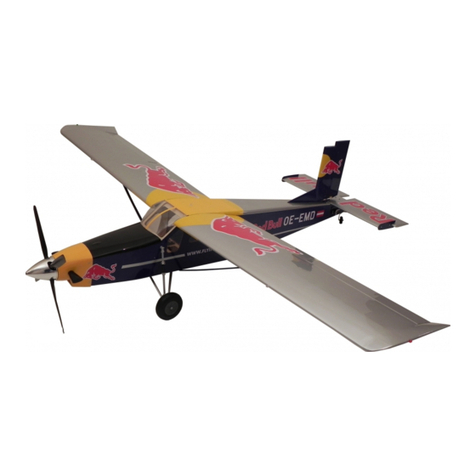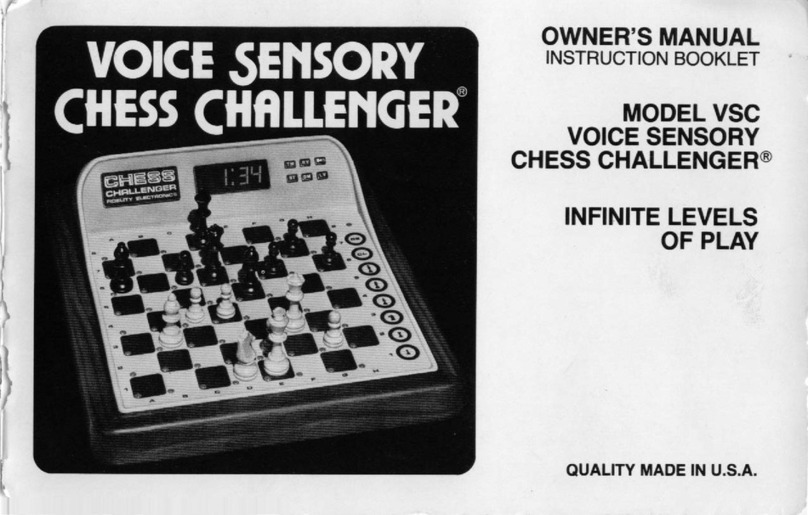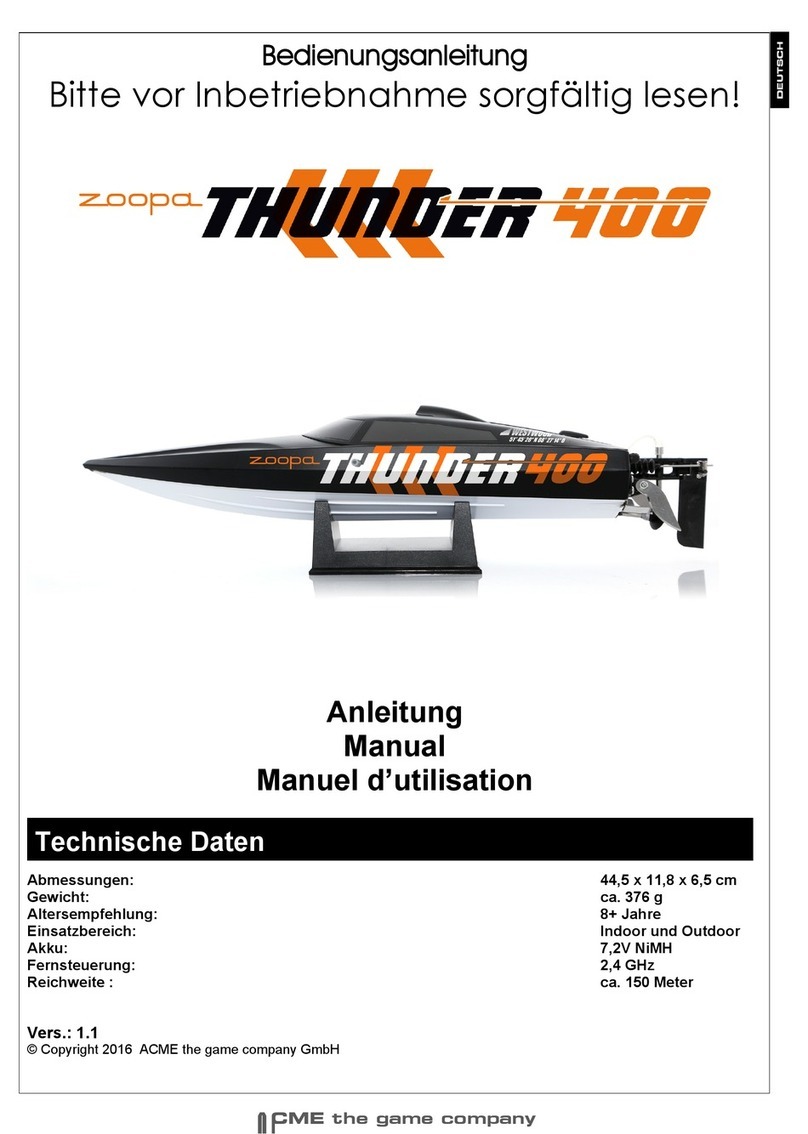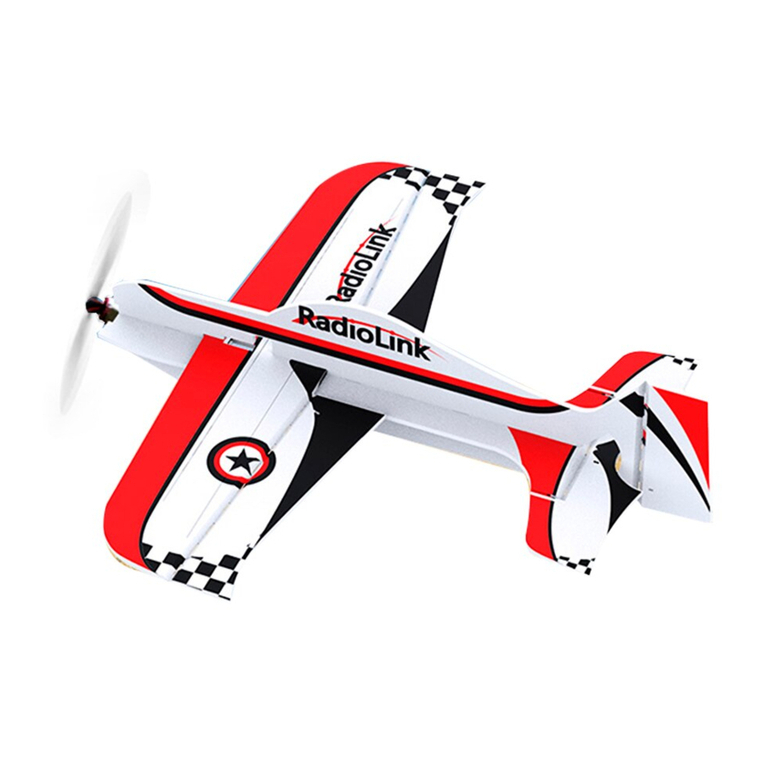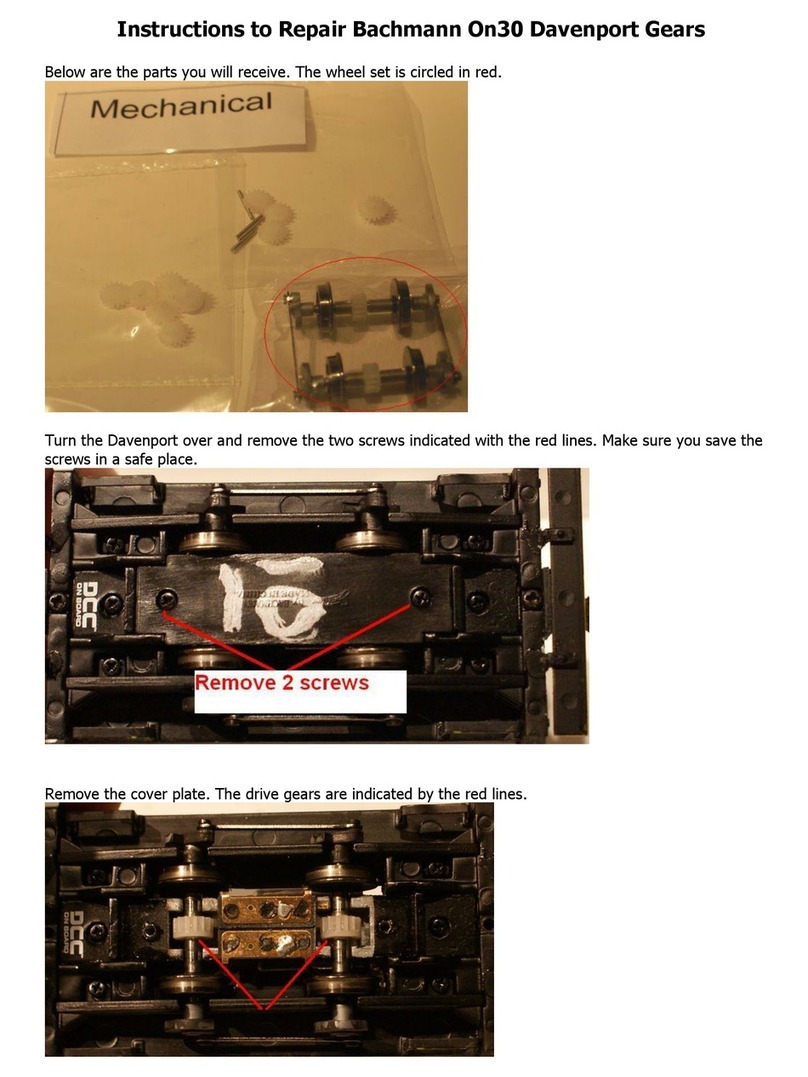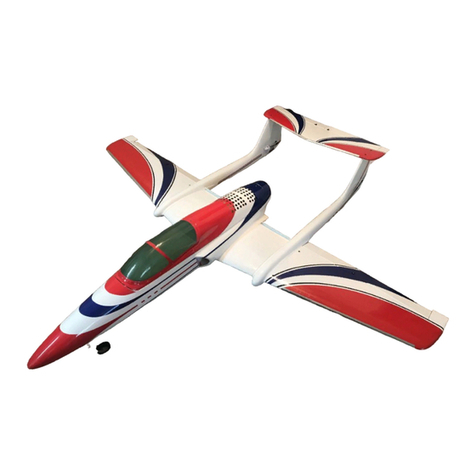Spartan Quark User manual


SPECIFICATION
Radio compatibility: All PCM, PPM and 2.4GHz radios
supporting the standard servo connector pinout (signal,
power, ground).
Servo compatibility: Digital servos as specified in this user
guide.
Servo pulse resolution: 250nSec
Operating voltage: 3.8V – 8.4 Volts, current draw <75mA
Dimensions: 20.6mm x 20.6mm x 9.1mm
Weight: Alloy case 10.2g, plastic 8.2g with all cables.
Operating conditions: -15 to 55 deg C, 5 to 131 deg F, 20
to 85 % humidity non condensing.
Storage: 10 to 70 deg C, 50 to 158 deg F, 20 to 90 %
humidity non condensing.
TROUBLESHOOTING, WARRANTY & REPAIRS
Should you encounter any problems, please do not return this
product to the store until you have carefully read this user
guide, consulted the knowledge base on the Spartan website
and sought advice from our technical support staff.
For repairs, servicing, technical support or questions
regarding the distribution of this product visit the support
page at the Spartan website: http://www.spartan-rc.com/

1
CONTENTS
Specification................................................... inside cover
Overview ...................................................................... 3
Interconnections ............................................................ 3
Status Light .................................................................. 4
Setting up your gyro for the first time ............................... 5
Gyro Mounting ............................................................... 6
Linkage Setup................................................................ 8
Servo Type Selection ...................................................... 9
Gyro Configuration ....................................................... 11
Gyro Gain and Mode ..................................................... 14
Tail Rotor Pitch ............................................................ 16
Operation.................................................................... 17
Advanced Configuration Options ..................................... 19
Copyright and Licence................................................... 19
Warranty and Product Registration.................................. 20
Spare Parts and Accessories .......................................... 21
Liability Disclaimer ....................................................... 21
Important: This user guide [Doc. v1.0] was accurate at the
time of printing. As the firmware evolves some of the
configuration options described in here may have changed.
For firmware release notes visit the support knowledge base
on the Spartan website and consult topic 89.

2
WARNING!
Model helicopters are not toys and have the potential to be
very dangerous. Failure to follow the safety precautions and
warnings in this user guide may result in severe injury to
yourself and others. Beginners are advised to seek further
advice from an experienced adult pilot.
Read through the entire manual before operating this product.
This product contains chemicals known to the State of
California to cause cancer and birth defects or other
reproductive harm.
Safety Precautions
BEFORE EACH FLIGHT:
• Verify that the gyro operates correctly.
• Verify that the gyro compensates in the correct direction.
• Verify that the gyro is operating in the desired mode.
• Verify that the gyro mounting pads are in good condition.
• Verify that the gyro wires are not contacting the frame of
the helicopter.
• Verify that all tail linkages, ball links and tail hub bearings
can move freely without excessive friction.

3
OVERVIEW
Measuring a mere 20.6mm square and 9.1mm tall (0.81 x
0.81 x 0.36 inch) your new Spartan QuarkTM gyro is the
smallest and lightest heading hold gyro in its class. Its
cutting-edge MEMS (Micro Electrical Mechanical System)
sensor, powerful Digital Signal Controller and Spartan’s
market leading adaptive tail control technology offer optimal
gyro performance and exceptionally consistent yaw rates on
any size helicopter from tiny electric to the largest nitro
helicopters. The holding ability of the gyro is excellent and
precise giving a very solid and dependable feel.
INTERCONNECTIONS
(red plug)
Connect to receiver’s
gyro gain output. Also
used for data link.
(black plug)
Connect to receiver’s
rudder output.
Connect to digital
tail servo.

4
STATUS LIGHT
Status Light
Description
Operating Mode
Steady
r
ed
Rate mode.
Steady blue
AVCS mode.
Blue 2 flashes
AVCS mode -
Rudder stick not
centred.
Blue slow
flashing
Start conditions not met. Gyro gain
is set to less than 5%.
Alternating
blue/red
Gyro calibrating.
Error Codes
Red slow
flashing
Gyro not receiving both rudder and
gain signals. Possibly not produced
by the receiver.
Red 1 flash
Gyro not receiving rudder signal.
Rudder plug is fitted incorrectly or
broken yellow wire.
Red 2 flashes
Gyro not receiving gain signal.
Gain plug is fitted incorrectly or
broken orange wire.
Red 3 flashes
Power on calibration or self-test
failed. Cycle power. If the problem
persists contact technical support.
Set
up
Steady violet
or
flashing
See Servo Type Selection and Gyro
Configuration sections.

5
SETTING UP YOUR GYRO FOR THE FIRST TIME
Follow the steps below in the specified order to successfully
deploy your new Spartan gyro.
Fix the gyro on your model following the instructions shown
in the Gyro Mounting section later in this guide.
Connect the gyro to the receiver as shown in the
Interconnections section of this guide. Do not connect
the servo to the gyro at this time.
Ensure that the transmitter trims and sub-trims are set to
zero and that collective pitch to tail pitch mixing is disabled.
Select the correct servo type as described in the Servo
Type Selection section of this guide.
Connect the servo to the gyro.
Follow the instruction in the Linkage Setup section of this
guide to set the correct mechanical geometry of the tail.
Adjust rudder direction reversing at your transmitter.
Configure gyro reversing and servo endpoint as described
in the Gyro Configuration chapter if this guide.
Adjust gyro gain for both Rate and AVCS modes via your
transmitter. See Gyro Gain and Mode section.
Confirm tail rotor pitch changes in the correct direction to
oppose any movement of the tail. Confirm the rudder stick
produces the desired tail pitch movement and that there is
no mechanical binding. See Tail Rotor Pitch section.

6
GYRO MOUNTING
The correct operation, performance and stability of your
Spartan gyro can be greatly affected by the way it is fixed on
the aircraft.
WARNING!
• It is essential that the gyro is mounted on a rigid flat
surface accurately perpendicular to the main shaft.
• Do not mount the gyro in locations where it may be
subjected to high levels of oily smoke, fuel, or other liquids.
• Do not allow the gyro case to touch other objects.
• Do not allow the gyro cable to touch the sharp edge of the
helicopter frames.
• Avoid mounting the gyro in direct proximity to other
electronic equipment and particularly servos.
• Avoid fixing the cable to the helicopter for the first 5cm (2
inches) from the gyro end to reduce transmission of vibrations
through the cable.
• Do not fit cable braid over the gyro wires.
• Inspect the condition of the adhesive pads as part of your
regular pre-flight checks.

7
3mm adhesive foam pad
Stainless steel
p
late
1mm tape o
r
3mm foam pad
SET button on rea
r
side of gyro
The supplied mounting kit contains a stainless steel plate and
adhesive foam pads which have been selected by Spartan to
give the correct mass and shore hardness for effective
vibration damping. Always use the supplied mounting pads or
the Spartan replacement mounting pads available from your
Spartan gyro retailer.
Small electric helicopters (250, 450 and 500 size) – Use
a single 3mm foam pad without the steel plate.
Larger electric and nitro helicopters – Use a piece of the
1mm adhesive tape to mount the gyro on the steel plate and
a 3mm foam pad to mount the plate to the helicopter.
High vibration environments – Use a 3mm foam pad on
each side of the supplied steel plate.

8
90°
Small Electric
Helicopters
(250, 450 and 500)
Ball link 7.5mm
from servo shaft
LINKAGE SETUP
The optimal mechanical setup is essential for getting the best
performance from your high end Spartan gyro. Ensure that
any slop in the system is kept to a minimum and that the tail
pitch linkages can move freely without excessive friction
through any guides, ball links or other joints.
With the gyro set to Rate mode and the rudder stick
positioned at the centre the servo arm should be at a 90°
angle with the pushrod as illustrated. To fly in Rate mode set
the linkage lengths for approximately 8° tail pitch in the
direction that compensates the main rotor torque.
Follow the advice in
the helicopter’s
assembly manual
regarding the
placement of the ball
link onto the tail
servo horn. When
such advice is not
provided or has
resulted in poor tail
performance we
recommend placing

9
90°
Larger Electric and
All Nitro Helicopters
13.5 -
16.5mm
from servo shaft
the ball link at
7.5mm in the
case of small
electric
helicopters and
13.5 - 16.5mm
for the larger
electric and all
nitro
helicopters.
Alternatively
you may choose to place the ball link at a distance that allows
the servo to have a combined travel of around 80° from the
low endpoint to the high endpoint.
SERVO TYPE SELECTION
Spartan gyros are designed to work with all modern digital tail
servos and offer a selection of servo pulse modulations in
order to achieve such broad compatibility.
To access the servo configuration mode hold the SET button
pressed before powering on the gyro. Continue to hold the
SET button pressed until the Status light starts flashings in

10
violet colour. The number of flashes indicates the currently
selected servo type.
WARNING!
The selected servo type must match the servo you are using.
Incorrect setting may damage the servo and possibly
resulting in a loss of tail control during flight.
You must change the servo type before connecting the servo
to the gyro. Disconnect the servo if already connected.
Do not attempt to use analogue servos. Severe damage may
be caused to your servo or loss of tail control during flight.
Do not attempt to fly your model while the servo type
selection mode is active, tail stabilisation will not function.
To change the servo type move the rudder stick left or right
until the desired option is reached. Press the SET button once
to store your selection. The Status light turns on in steady
violet colour to acknowledge that the servo type is changed.
You may now power off the gyro.

11
Light Servo modulation
1 flash
(default)
1520uSec at 333Hz
Futaba S9253 / S9254 / S9257 / S9650 / S3153 /
S3154, BLS254, JR 8900G / 3400G / 3500G, Align
DS410 / DS420 / DS510 / DS520 / DS610 / DS620 /
DS650, Sanwa ERG-WRX, Airtronics 94758 / 94761,
Hitec 5925MG / 6965HB / 5083MG, Robbe FS61BB
2 760uSec at 560Hz
Futaba S9251 / S9256 / BLS251, MKS DS8910 /
BLS980
3 1520uSec at 250Hz
JR 2700G / 8700G / 810G, Sky HDS-577 / HDS-877
4 960uSec at 333Hz
LogicTech 6100G / 3100G, Hitec 5083MG
Not listed servos - If your servo is not listed in the above
table please visit the support knowledge on the Spartan
website and consult topic 12.
GYRO CONFIGURATION
To access the configuration mode power on the gyro and wait
until it has finished calibrating. Press and hold the SET button
for a few seconds. Once the configuration mode is active the
tail servo chatters twice then rests in its centre position.

12
WARNING!
Do not attempt to fly your model while the gyro configuration
mode is active, tail stabilisation will not function.
Before configuring your gyro ensure that the rudder reversing
has been correctly set at the transmitter. The gyro relies on
this configuration to adjust its internal gyro direction
reversing as required. Failure to follow this step correctly
could result in violent pirouetting on take-off and loss of tail
control. Before proceeding confirm the correct operation of
the rudder stick by observing the tail rotor blades as
explained in the Tail Rotor Pitch section of this guide.
To prevent damage to the servo disconnect the tail control
linkage from the servo before entering the gyro configuration
mode. During adjustments simply hold the linkage over the
linkage ball.
Step 1: Gyro direction reversing
The first parameter to be configured is gyro direction
reversing. Simply push the rudder stick to the left and the
gyro will automatically match your radio system. As the
rudder stick is operated the tail blades move to allow visual
confirmation of the correct rudder behaviour. The Status light
switches on/off in violet to indicate if reversing is active.

13
When satisfied, press the SET button briefly. The servo will
chatter once to confirm completion of this step.
Important: If the gyro is mounted in an inverted orientation
you will need to push the rudder stick to the right instead.
Step 2: Adjust low servo endpoint
The servo is now resting at the low endpoint position and the
Status light is flashing violet twice. Using the rudder stick
adjust the servo position until you achieve maximum tail rotor
pitch without binding on the mechanical limits. When
satisfied, press the SET button briefly. The servo chatters
once to confirm completion of this step.
Important: Always set the gyro endpoints for the maximum
available tail rotor pitch. This defines how much pitch the gyro
can use and has no effect on how responsive the gyro feels in
flight. If you find the yaw very responsive or very slow for
your preference you may adjust this via the transmitter’s
endpoints or Dual Rate setting for the rudder channel.
Note: Whilst crossing the 100% endpoint value the servo
pauses momentarily and the status light flashes blue.

14
Step 3: Adjust high servo endpoint
The servo is now resting at the high endpoint position and the
Status light is flashing violet three times. Using the rudder
stick adjust the servo position for maximum tail rotor pitch
without binding. When satisfied, press the SET button briefly.
The servo chatters twice to confirm completion of the
configuration mode.
Upon completion the gyro stores the new configuration to its
internal memory and the Status light is steady violet. You
may now power off the gyro.
GYRO GAIN AND MODE
Spartan gyros offer two operating modes, the classic Rate
type and the AVCS (Angular Velocity Control System). To
control the operating mode assign the gain channel to a two
position switch of your transmitter. This switch now selects
the operating mode whilst the gain channel endpoints control
gyro gain for each mode. Your radio may also offer a
dedicated gyro menu with more advanced configuration
options for the gyro gain setting.
The following table shows the relationship of the gyro
operating gain in respect to the displayed value on the screen
of some popular radio control transmitters.

15
Gyro Operating Gain > 100%
Rate
80%
0% 77% 100%
AVCS
Gain Pulse Width 1020uS
1520uS
2020uS
Futaba Gyro Menu 100% 0% 100%
Futaba Endpoints 90% 0% 90%
JR/Spektrum Gyro Menu - 0% 51% 100% -
JR/Spektrum Endpoints 126% 1% 129%
Important:
• The optimal gain value is the highest value you can reach
that does not cause tail wag at any time during flight.
• Do not use any type of stick priority mixing or other gain
reduction mixing.
The optimal gain value is a function of several parameters
including rotor speed, tail rotor diameter, tail blade efficiency,
servo arm length, servo make/model and mechanical design
of the aircraft. As such, it is not possible to make a general
recommendation and therefore the gain will need to be
adjusted experimentally. Start with a gain of 30%, this should
provide enough stability to at least hover; however you
should always proceed with care. If insufficient stabilisation or
tail wag is seen the gain should be raised or lowered
respectively. It is not uncommon to find that the optimal gain
value for a helicopter could be as small as 35-45%. A small

16
value does not mean that the gyro will be limited in
performance. Any gain value performs well as long as it is the
optimal gain value. However, a gain below 30% indicates that
the mechanical gain of the tail is too high and therefore it is
recommended to move the servo arm ball link further in.
Similarly if 100% is reached and no tail wagging is seen the
ball link needs to be moved further out.
TAIL ROTOR PITCH
Left rudder
input
Right rudder
in
p
ut
Airframe
manually
rotated
CW
|
OR
|
Airframe
manually
rotated
CCW
|
OR
|
Tail rotor
thrust
Tail rotor
thrust
Tail blades as
seen from above
Tail blades as
seen from above

17
OPERATION
It is advisable to power on the gyro in AVCS mode which
enables it to recalibrate the rudder stick neutral. Stick neutral
recalibration is not possible in Rate mode as any tail rotor
mixing will interfere with the accuracy of this measurement.
However should the gyro be accidentally powered on in Rate
mode it will make use of the last known calibration value.
WARNING!
Immediately after powering on, the gyro performs automatic
calibration of the rudder stick and gyro sensor resting
positions. During this time the helicopter must remain
undisturbed and the rudder stick must be left at the centre
position. Calibration lasts approximately 4 seconds and upon
completion the gyro will enter flight mode and the tail servo
will move to its midpoint. During calibration the Status light
colour alternates rapidly between red and blue.
The calibration will not start if the gyro is not receiving the
required rudder and gain signal from the receiver, or the start
conditions are not met. In both cases the Status light will emit
a flashing pattern to indicate the cause. These flashing
patterns are listed in Status Light section of this guide.

18
WARNING!
If you plan on using the gyro in Rate mode you may need to
program collective to tail rotor mixing on your transmitter.
You must ensure that such mixing is active in Rate mode only.
If the tail rotor mixing remains active in AVCS mode it can
result in violent pirouetting and loss of tail control.
If tail drift is seen in Rate mode it is advisable to trim the
model mechanically by adjusting the linkage lengths. Small
corrections can be done using the transmitter’s rudder trim,
though this is not recommended. In the event that the
transmitter’s trim is changed the gyro needs to recalibrate the
rudder stick neutral. To do this, land and spool down the
model, then rapidly toggle the gain switch three times
(transitioning between Rate and AVCS modes) before
returning it to the AVCS position. The rudder stick must be
resting at the centre position while recalibration takes place.
Important: If the radio’s rudder endpoints are set to a very
high value, which results in a yaw demand above the sensing
range of the gyro, the tail pitch will open fully producing ultra-
fast yaw rate of over 3 turns per second. While such fast yaw
rates are spectacular you must ensure that your model is
mechanically capable to withstand the increased loads.
Table of contents



